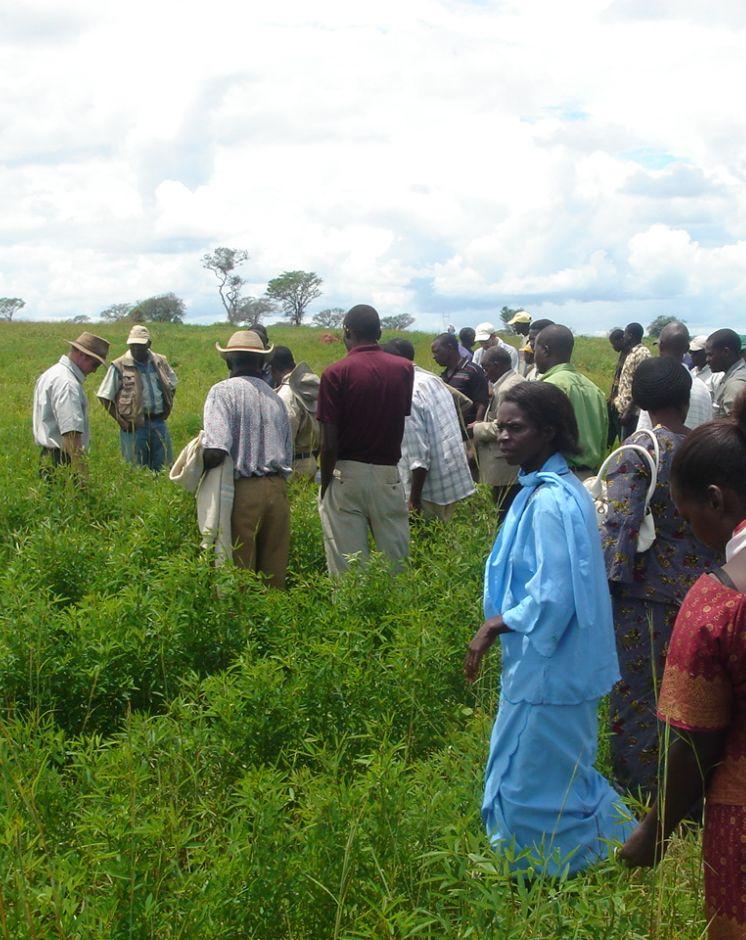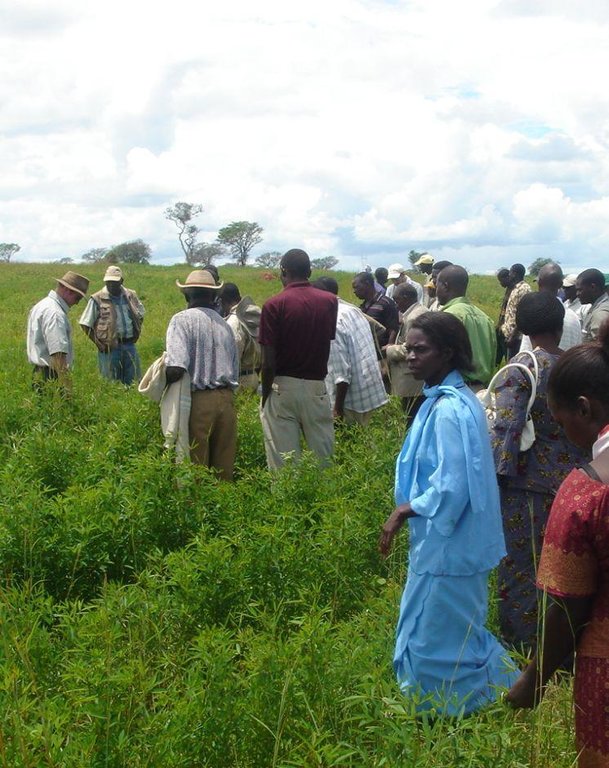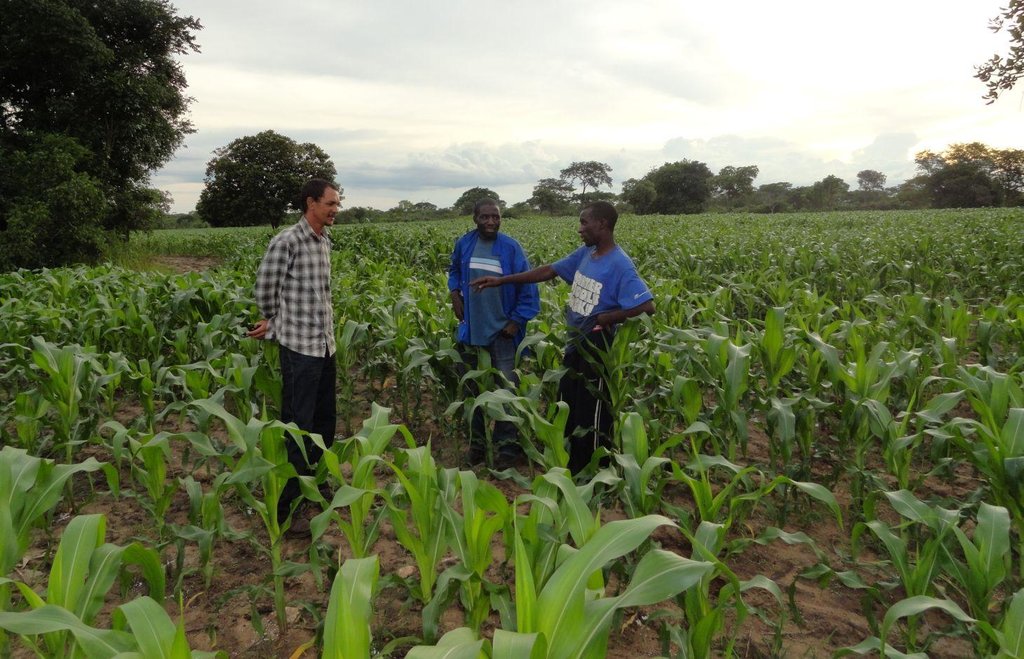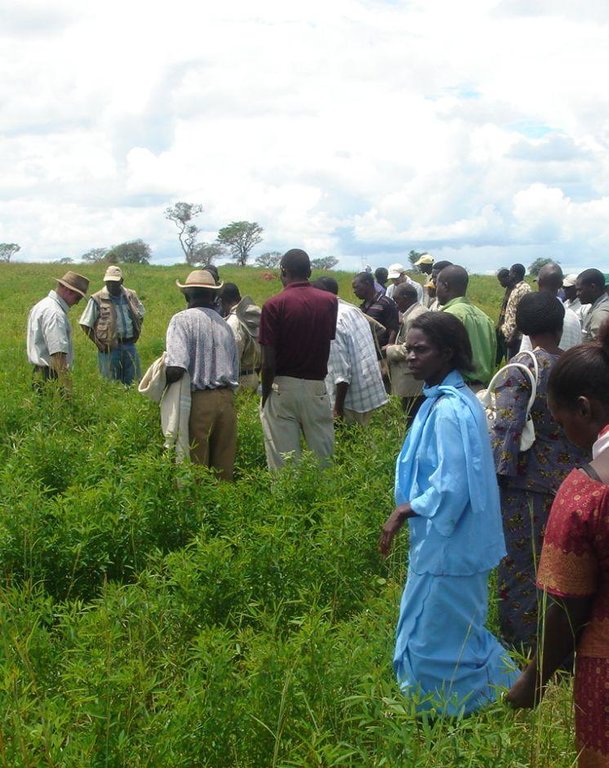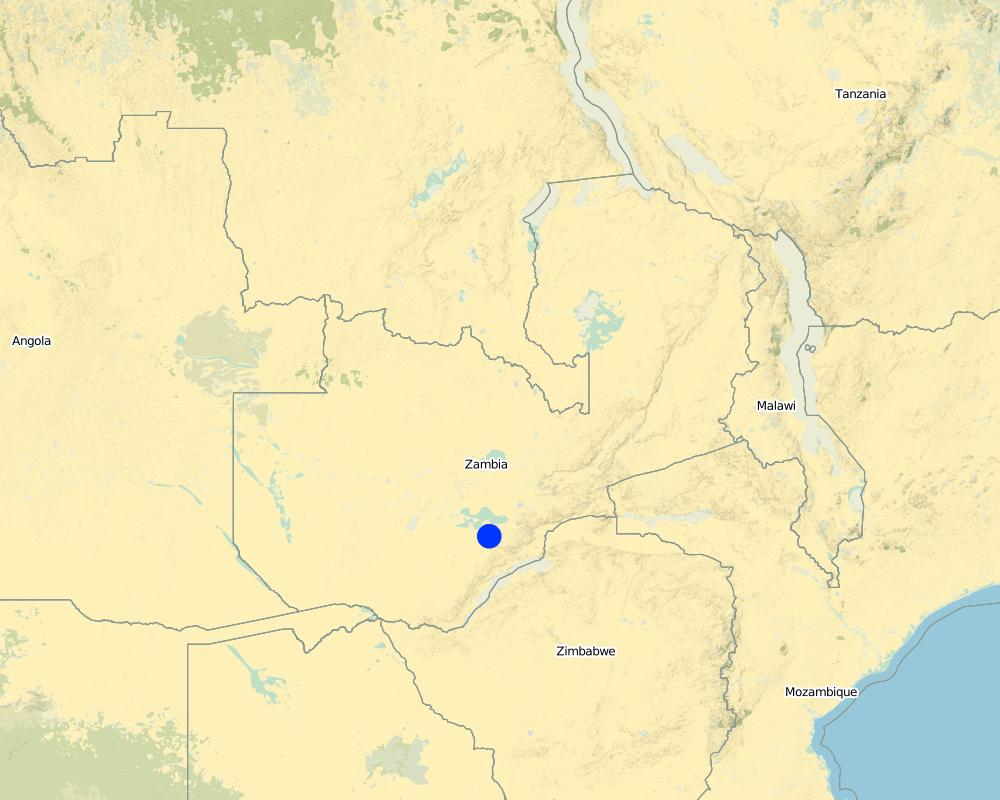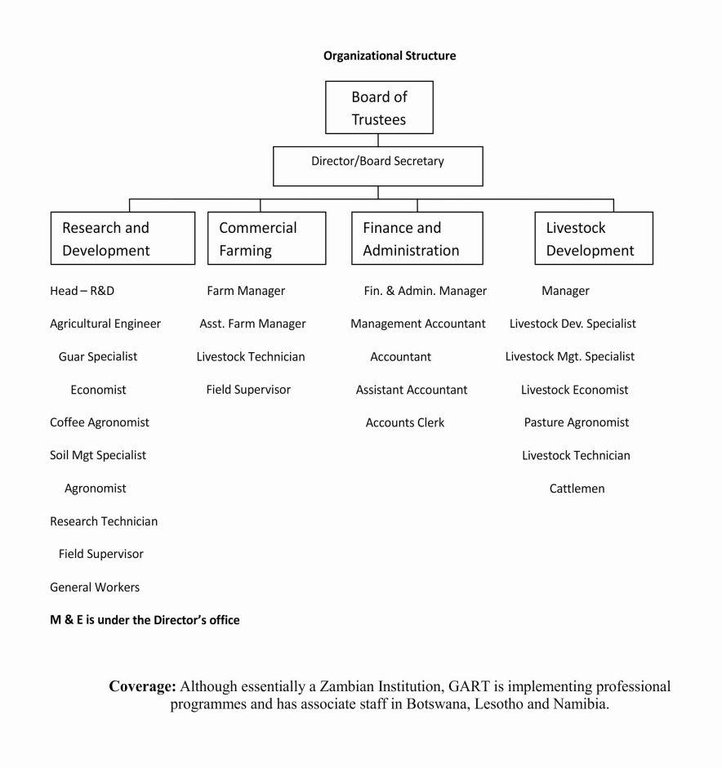Participatory Research and Development [Замбия]
- Создание:
- Обновить:
- Составитель: Arthur Chomba
- Редактор: –
- Рецензент: Fabian Ottiger
on-farm research
approaches_2464 - Замбия
Просмотреть разделы
Развернуть все Свернуть все1. Общая информация
1.2 Контактные данные специалистов и организаций, участвующих в описании и оценке Подхода
Специалист по УЗП:
Ndandula Sharon
Gart
Замбия
Специалист по УЗП:
Katoweji Alfred
GART
Замбия
Специалист по УЗП:
Chingulu Sylvester
Ministry of Agriculture
Замбия
Специалист по УЗП:
Wamunyima Silenga
+260 97 7490657
wamzysilenga@rocketmail.com
GART
Замбия
Название организации (-ий), содействовавших документированию/оценке Подхода (если применимо)
Golden Valley agricultural research trust (Golden Valley agricultural research trust) - ЗамбияНазвание организации (-ий), содействовавших документированию/оценке Подхода (если применимо)
Ministry of Agriculture of Zambia (MoA) - Замбия1.3 Условия, регламентирующие использование собранных ВОКАТ данных
Когда были собраны данные (на местах)?
16/01/2013
Составитель и ответственный/-ые специалист(-ы) согласны с условиями, регламентирующими использование собранных ВОКАТ данных:
Да
1.4 Ссылка (-и) на Анкету (-ы) по Технологиям УЗП

Animal Draft Zero-Tillage [Замбия]
Animal draft zero-till involves the use of an animal drawn mechanical planter to plant directly in untilled soil to minimize soil disturbance and leave a cover of crop residues to conserve the soil and water.
- Составитель: Silenga Wamunyima

Strip Tillage Conservation Farming [Замбия]
Strip Tillage Conservation Farming is an animal draft reduced tillage method that involves loosening a strip of soil with a strip tillage tool so as to reduce soil disturbance and improve soil and water conservation.
- Составитель: Silenga Wamunyima
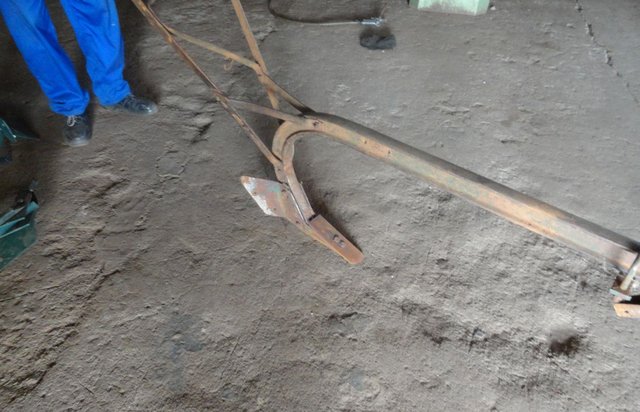
Conservation Tillage with Magoye Ripper [Замбия]
Conservation Tillage with the Magoye Ripper is an animal draft reduced tillage method that involves the use of the Magoye Ripper to loosen the soil by shattering with a tine instead of ploughing.
- Составитель: Silenga Wamunyima
2. Описание Подхода УЗП
2.1 Краткое описание Подхода
This is a collaborative process between researchers and farmers for developing and adapting new technologies that focus on incorporating the perspectives and inputs from the farmers into the development process.
2.2 Подробное описание Подхода
Подробное описание Подхода:
Aims / objectives: (1)To stimulate active farmer participation in the technology development process so that local conditions and perspectives are integrated in the process. (2)Build the capacity of farmers to identify problems and contribute to selecting/improving technology options. (3) Raise farmers’ yields in a sustainable manner and ultimately contribute to increased net farm income.
Methods: A series of on-farm experiments are set up to test a range of technology options. These trials are implemented by the farmers so that vital feedback on which technology works and why it does so is collected. Suggestions for improvements are also collected, reviewed and incorporated into new designs or all together new technologies developed. The process is repeated until spontaneous adoption is evident before the technologies are promoted widely.
Stages of implementation: (1) Preparation of trial protocols for technologies to be tested (2) Identification of farmers and mobilization into farmer groups (3) Capacity building and increasing the knowledge base of farmers to effectively participate and contribute to development process. (4) Setting up of on-farm trials (5) Monitoring trials and collecting data/feedback from farmers (6) incorporation of feedback into technology development process and conducting on-station trials (7) technologies adapted or developed and introduced and the process is repeated.
Role of stakeholders: The approach was designed by national specialists where ‘best-bet’ technologies were pre-selected for testing. The role of GART was that of research and training of trainers. The supervision of the farmers was carried out by government extension workers who were supervised by the researchers and GART field technicians. The farmers implemented the approach and the decision on which technology to adopt was made by them. The land users also participated in evaluating the technologies and made suggestions on possible improvements. The decision on how best to consolidate these suggestions and incorporate them into the technologies was made by the specialists in consultation with the land users.
2.3 Фотографии, иллюстрирующие Подход
2.5 Страна/ регион/ место, где применялся Подход
Страна:
Замбия
Административная единица (Район/Область):
Zambia
Более точная привязка места:
Mazabuka/Magoye
Map
×2.6 Даты начала и окончания реализации Подхода
Год начала реализации:
1995
2.7 Тип Подхода
- в рамках проекта/ программы
2.8 Каковы цели/ задачи Подхода
The Approach focused mainly on SLM with other activities (Increasing agricultural productivity, improving livelihoods )
(1)To stimulate active farmer participation in the technology development process so that local conditions and perspectives are integrated in the process. (2)Build the capacity of farmers to identify problems and contribute to selecting/improving technology options. (3) Raise farmers’ yields in a sustainable manner through technology innovation and ultimately contribute to increased net farm income.
The SLM Approach addressed the following problems: Unsustainable farming practices leading to environmental degradation and low agricultural productivity
2.9 Условия содействующие применению Технологии/ Технологий в рамках Подхода или затрудняющие его
Социальные/ культурные/ религиозные нормы и ценности
- затрудняют
The participation of women not as much as that of men
Treatment through the SLM Approach: Women headed households were identified and targeting for inclusion in the project
Наличие/ доступность финансовых ресурсов и услуг
- затрудняют
The short cycle of projects and funding that made long-term planning difficult
Treatment through the SLM Approach: Collaborate with government structures and extension service to ensure sustainability of the project
Институциональные условия
- затрудняют
Weak collaboration between organizations promoting conservation agriculture (CA) leading to mixed messages being delivered to farmers
Treatment through the SLM Approach: Formation of the Conservation Farming Association (CAA) to synchronise messages and avoid duplication of efforts
Нормативно-правовая база (землевладение, права на земле- и водопользование)
- затрудняют
Lack of secure land tenure leading to hesitancy to invest in long-term conservation efforts
Treatment through the SLM Approach: Emphasise the short-term benefits of conservation
The existing land ownership, land use rights / water rights moderately hindered the approach implementation Lack of secure land tenure discourages land user from seeking long-term conservation efforts
Осведомленность в области УЗП, доступность технической поддержки
- затрудняют
The failure of rural workshops to produce and supply the necessary equipment for the implementation of the approach
Treatment through the SLM Approach: Collaboration was initiated with mainstream equipment suppliers
другие
- затрудняют
Low returns from the sale of the staple crop (maize) and hence low returns to farming general
Treatment through the SLM Approach: Encourage crop livestock integration and promote crop diversification
3. Участие и распределение ролей заинтересованных сторон
3.1 Заинтересованные стороны, участвующие в реализации Подхода и их роли
- местные землепользователи/ местные сообщества
Community based organizations for HIV/AIDS affected people
Most of the households are male headed. of the 250 farmers registered in Magoye, only 22 were female headed.
- эксперты по УЗП/ сельскому хозяйству
Researchers and government extension
- ученые-исследователи
Researchers and government extension
- государственные власти (отвечающие за планирование или принятие решений)
Government extension implemented the approach after training from GART. Politicians were lobbied to mainstream CA in govt programmes
GART, the main implementing body is a quasi-government body
3.2 Участие местных землепользователей/ местных сообществ на разных стадиях реализации Подхода
| Участие местных землепользователей/ местных сообществ | Перечислите участников и опишите их вовлеченность | |
|---|---|---|
| инициирование/ мотивация | интерактивное | Approach inititated by specialists based on interactions with land-users from previous programmes |
| планирование | пассивное | Planning was done by specialists although farmers were informed and consulted at every stage |
| выполнение | интерактивное | Land users implemented the approach with the help of specialists |
| мониторинг/ оценка | пассивное | Monitoring/evaluation was done by the specialists together with the land users as well as external evaluators |
| Research | интерактивное | Research was done by the specialists together with the land users |
3.3 Схема реализации (если имеется)
Описание:
Golden Valley Agricultural Research Trust (GART) is an autonomous and self-sustaining
Public Private Partnership organization in 1993 created by the Government of Zambia and the Zambia National Farmers Union GART is member of the Zambia National Farmers Union (ZNFU).
Автор:
Silenga Wamunyima (Mazabuka/Southern Province/Zambia)
3.4 Принятие решений по выбору Технологии/ Технологий УЗП
Укажите, кто принимал решение по выбору применяемой Технологии/ Технологий:
- в основном землепользователи при поддержке специалистов по УЗП
Поясните:
The choice of which technology to test was made by the specialist but the choice of which technology to implement was made by the land users
Decisions on the method of implementing the SLM Technology were made by mainly by land users supported by SLM specialists
4. Техническая поддержка, повышение компетенций и управление знаниями
4.1 Повышение компетенций/ обучение
Проводилось ли обучение землепользователей/ других заинтересованных лиц?
Да
Укажите, кто проходил обучение:
- землепользователи
- местный персонал/консультанты
Тип обучения:
- обмен опытом между фермерами
- опытные участки
- общие собрания
Рассматриваемые темы:
soil conservation and soil fertility improvement, how to use the conservation agricultural technologies, crop-livestock integration
4.2 Консультационные услуги
Есть ли у землепользователей возможность получать консультации?
Да
Укажите, где именно оказываются консультационные услуги:
- на полях землепользователей
Описание/ комментарий:
Name of method used for advisory service: Training of Trainers; Key elements: trainig of goverment extension workers and NGOs promoting of conservation agriculture (CA), on-farm demonstrations, field days
Advisory service is inadequate to ensure the continuation of land conservation activities; There are too few extension workers and there aren’t sufficient training manuals
4.3 Институциональная (организационная) поддержка
В ходе реализации Подхода были ли организованы новые институциональные структуры или поддержаны уже существующие?
- да, умеренно
Укажите уровень, на котором структуры были укреплены или вновь созданы:
- местные
Укажите тип поддержки:
- повышение компетенций/ обучение
- оборудование
Подробнее:
Capacity building of local cooperatives and farmer associations, training of trainers and practical demonstrations
4.4 Мониторинг и оценка
Являются ли мониторинг и оценка частью Подхода?
Да
Комментарии:
bio-physical aspects were regular monitored by project staff, land users through observations; indicators: Soil properties, moisture conservation
bio-physical aspects were ad hoc monitored by project staff through measurements; indicators: soil miosture, soil fertility
technical aspects were regular monitored by project staff through observations; indicators: Yield, production area, labour, timeliness
technical aspects were None monitored by project staff through measurements; indicators: equipment breakdowns
socio-cultural aspects were None monitored by project staff through observations; indicators: Gender, mindset, status
economic / production aspects were None monitored through observations; indicators: Yields, labour inputs, costs, income, adoption
no. of land users involved aspects were monitored through observations
There were several changes in the Approach as a result of monitoring and evaluation: There was more emphasis on on-farm trials as the project went on with more training on weeding techniques and crop-livestock integration
There were several changes in the Technology as a result of monitoring and evaluation: The Magoye Ripper (T_ZAM003en) was modified to penetrate deeper and an altogether new technology called the Magoye Planter (Strip Tillage T_ZAM002en) was developed to overcome some of the constraints of the Magoye Ripper.
4.5 Научные исследования
Были ли научные исследования частью Подхода?
Да
Укажите темы исследований:
- технология
Напишите подробнее и назовите тех, кто выполнял исследования:
Research by GART focused on equipment development and adaptation of soil improvement technologies to make Conservation Agriculture (CA) a viable option for animal draft farmers
Research was carried out both on station and on-farm
5. Финансирование и внешняя материальная поддержка
5.1 Годовой бюджет мероприятий по УЗП в рамках Подхода
Если точный годовой бюжет неизвестен, укажите примерный диапазон затрат:
- 2000-10000
Комментарий (например, основные источники финансирования/ ключевые доноры):
Approach costs were met by the following donors: local community / land user(s) (Land preparation by land user(s)): 100.0%
5.2 Финансирование и внешняя материальная поддержка, предоставляемая землепользователям
Предоставлялась ли землепользователям финансовая/ материальная поддержка для применения Технологии /Технологий?
Да
Если да, укажите тип(-ы) поддержки, кто ее предоставил и условия предоставления:
Mostly contributions from EU supplemented by finances from commercial activities i.e. commercial crop production and contract research
5.3 Субсидии на отдельные затраты (включая оплату труда)
- оборудование
| Укажите, какие ресурсы были субсидированы | В какой степени | Опишите субсидии подробнее |
|---|---|---|
| инвентарь/ инструменты | профинансированы частично | |
Если труд землепользователя был существенным вкладом, укажите, был ли этот вклад:
- добровольный
Комментарии:
GART only provided technical support while the farmer provided all the inputs, labour
5.4 Кредитование
Предоставлялись ли в рамках Подхода кредиты на мероприятия УЗП?
Нет
6. Анализ влияния и заключительные положения
6.1 Влияние Подхода
Сумел ли Подход помочь землепользователям внедрить и поддерживать технологии УЗП?
- Нет
- Да, немного
- Да, умеренно
- Да, существенно
The farmers that adopted the Magoye Ripper were ploughing (pulverising) less thereby reducing erosion and loss of organic matter. However, some of the technologies have not been adopted on a wide enough scale to create an impact at community level. Even the farmers that did not adopt the technologies are now more aware of the need for soil conservation.
Сумел ли Подход расширить возможности социально и экономически уязвимых групп?
- Нет
- Да, немного
- Да, умеренно
- Да, существенно
HIV/AIDS affected families and female headed households were specifically targeted
Сумел ли Подход разрешить правовые проблемы землевладения/ землепользования, препятствующие использованию технологий УЗП?
- Нет
- Да, немного
- Да, умеренно
- Да, существенно
Apart from lobbying policy makers, issues of land tenure were beyond the scope of the approach The problem is likely to be overcome in the near future. The problem has been acknowledged by politicians and addressed in the new draft constitution
Did other land users / projects adopt the Approach?
- Нет
- Да, немного
- Да, умеренно
- Да, существенно
On-farm research has been adopted by the Conservation Farming Unit (CFU) who are the biggest player in promotion of Conservation Agriculture in Zambia. There are not many other research organizations in Zambia
Did the Approach lead to improved livelihoods / human well-being?
- Нет
- Да, немного
- Да, умеренно
- Да, существенно
Increased income and improved food security, less labour constraints and more time for other economic activities
Did the Approach help to alleviate poverty?
- Нет
- Да, немного
- Да, умеренно
- Да, существенно
Increased income and improved food security, less labour constraints and more time for other economic activities
6.2 Основные причины, побуждающие землепользователей внедрять УЗП
- рост продуктивности
- рост прибыли (доходности) и рентабельности
- снижение объёма работ
- экологическая сознательность
6.3 Долгосрочная устойчивость мероприятий в рамках Подхода
Могут ли землепользователи самостоятельно (без внешней поддержки) продолжать применение того, что было реализовано в рамках Подхода?
- да
Если да, опишите как:
Adoption rates for Conservation Agriculture are still fairly low indicating that the practice is still fairly new and the technologies still need to be adapted and refined to suit local conditions. The farmers still need technical support until the bottlenecks with the practices are addressed and there is evident spontaneous adoption. This all depends on how well research and planners respond to the current challenges.
6.4 Сильные стороны/ преимущества Подхода
| Сильные стороны/ преимущества/ возможности по мнению землепользователей |
|---|
| Farmers well informed of current developments and technology advancements (How to sustain/ enhance this strength: Training farmers on current developments and technology advancements) |
| Сильные стороны/ преимущества/ возможности по мнению составителя или других ключевых специалистов |
|---|
| Farmers organizations strengthened (How to sustain/ enhance this strength: Capacity building) |
|
There is strong farmer involvement in technology adaptation (How to sustain/ enhance this strength: Increase the farmers knowledge base to ensure effective participation) |
6.5 Слабые стороны/ недостатки Подхода и пути их преодоления
| Слабые стороны/ недостатки/ риски по мнению составителя или ответственных специалистов | Возможные пути их преодоления/снижения? |
|---|---|
| Too little emphasis on knowledge transfer and too much on practical demonstrations and ‘how-to’ training. |
Focus more on understanding principles and technology selection |
7. Справочные материалы и ссылки
7.1 Методы сбора/источники информации
- выезды на места, полевые обследования
- опросы землепользователей
7.2 Ссылки на опубликованные материалы
Название, автор, год публикации, ISBN:
Impact study on the acceptance of the Magoye Ripper, Piet Stevens, David Samazaka, Ab Wanders, Douglas Moono, 2002 Conservation farming in Zambia, Steven Haggblade, Gelson Tembo, October 2003 Social-economic analysis of conservation agriculture in southern Africa, FAO, 2011Conservation farming in Zambia, Conservation farming unit (CFU), 2011
Где опубликовано? Стоимость?
GART/free onlineINDABA Project, Michigan State University/free onlineFAO/free onlinecfu@zamnet.zm
Название, автор, год публикации, ISBN:
Conservation farming in Zambia, Steven Haggblade, Gelson Tembo, October 2003
Где опубликовано? Стоимость?
INDABA Project, Michigan State University/free online
Название, автор, год публикации, ISBN:
Social-economic analysis of conservation agriculture in southern Africa, FAO, 2011
Где опубликовано? Стоимость?
FAO/free online
Название, автор, год публикации, ISBN:
Conservation farming in Zambia, Conservation farming unit (CFU), 2011
Где опубликовано? Стоимость?
cfu@zamnet.zm
Ссылки и модули
Развернуть все Свернуть всеСсылки

Animal Draft Zero-Tillage [Замбия]
Animal draft zero-till involves the use of an animal drawn mechanical planter to plant directly in untilled soil to minimize soil disturbance and leave a cover of crop residues to conserve the soil and water.
- Составитель: Silenga Wamunyima

Strip Tillage Conservation Farming [Замбия]
Strip Tillage Conservation Farming is an animal draft reduced tillage method that involves loosening a strip of soil with a strip tillage tool so as to reduce soil disturbance and improve soil and water conservation.
- Составитель: Silenga Wamunyima

Conservation Tillage with Magoye Ripper [Замбия]
Conservation Tillage with the Magoye Ripper is an animal draft reduced tillage method that involves the use of the Magoye Ripper to loosen the soil by shattering with a tine instead of ploughing.
- Составитель: Silenga Wamunyima
Модули
Нет модулей


